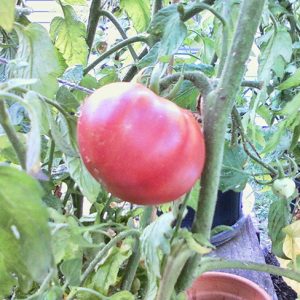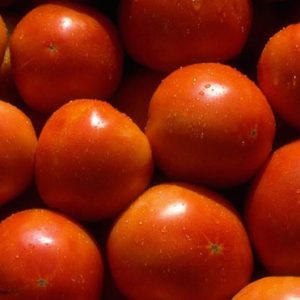calsfoundation@cals.org
Official State Fruit and Vegetable
aka: South Arkansas Vine Ripe Pink Tomato
In 1987, the Arkansas General Assembly conferred official state symbol status on the pink tomato, long a staple of Arkansas gardens. Act 255, introduced as House Bill 1480, asserted the aesthetic and culinary excellence of the Arkansas-grown tomato and determined that, because it was technically a fruit but generally consumed as a vegetable, it should serve as both in the state’s collection of official symbols. The act’s wording describes a type rather than specifying a species because there exists no registered breed styled “South Arkansas Vine Ripe Pink Tomato.” The measure was introduced by Representative John Lipton of District 90 whose constituency included Bradley County, long associated with Arkansas tomato production.
The state symbol status recognizes the role of the tomato in Arkansas agriculture and memorializes a cropping technique that has lost ground in the market. In the last half of the nineteenth century, Americans embraced the tomato as a healthy staple. Many varieties were grown, mainly for local or regional markets; excess production was canned. By the 1920s, southeast Arkansas market farmers favored strains of tomato that ripened to a pink hue and could be picked and shipped at “breaker” (first ripening). These were possibly descended from such pink “heirloom” strains as the Brandywine and the so-called Cherokee Purple, both identified before 1890. In 1959, Arkansas’s commercial tomato production exceeded 290,000 tons, with a market value of more than $2.5 million.
In 1956, citizens of Warren (Bradley County) organized a modest festival to honor the crop, which by then was known familiarly as the Bradley Pink. In 1961, University of Arkansas (UA) in Fayetteville (Washington County) agronomist Joe McFerran released a variety with the registered name of “Bradley Pink”: a pink-fruited plant resistant to wilt and suitable for staking or caging. A decade later, UA released another pink variety, the Traveler (sometimes incorrectly referred to as the “Arkansas Traveler”).
Arkansas remains a significant source of tomatoes for the U.S. market, although its contribution has dwindled. U.S. Department of Agriculture marketing figures for Arkansas tomato shipments show that, in 1989, southeast Arkansas producers shipped 11,820 tons of fruit. The 2004 total was 4,795 tons, in flats and cartons. The total for 2005 was 4,285 tons. Moreover, few of these fruit were other than red: the pink tomato’s market share has been eroded in recent years by supermarkets’ reliance on durable strains, picked green and force-ripened in warm rooms or by exposure to ethylene. Thick-skinned varieties are favored for this because they resist damage in shipping. Such fruit is available to consumers year round, but gourmets say it lacks the delicacy of flavor and texture of vine-ripened fruit. For Arkansas consumers, the vine-ripened pink tomato remains available in farmers’ markets and other locally sourced produce stands during summer. Warren continues to host the Pink Tomato Festival each June.
For additional information:
Bradley County Pink Tomato Festival. https://www.pinktomatofestival.com/ (accessed August 3, 2023).
Greenberg, Paul. “The Fruit of Time.” Arkansas Democrat-Gazette, June 20, 2001, p. G3.
“Tomatoes.” Arkansas Home and Garden. https://www.uaex.uada.edu/yard-garden/vegetables/tomato-gardening.aspx (accessed August 3, 2023).
Ware, David. It’s Official! The Real Stories behind Arkansas’s State Symbols. 2nd ed. Little Rock: Butler Center Books, 2017.
David Ware
Arkansas Secretary of State’s Office
 Agriculture
Agriculture Food and Foodways
Food and Foodways Bradley Pink Tomato
Bradley Pink Tomato  South Arkansas Vine Ripe Pink Tomato, Official State Fruit and Vegetable
South Arkansas Vine Ripe Pink Tomato, Official State Fruit and Vegetable 




Comments
No comments on this entry yet.